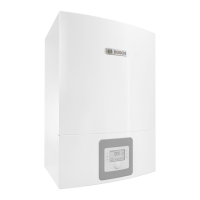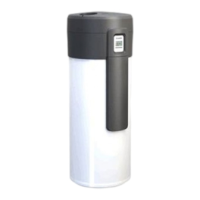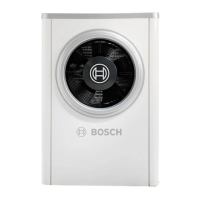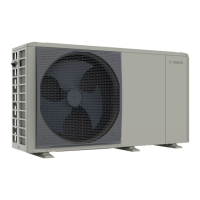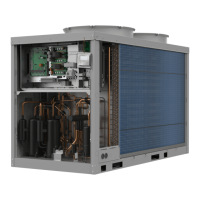4 | Overview of system
Compress 3000 AW6 720 818 009 (2015/07)
3 Overview of system
The heating system consists of two parts: the heat pump outdoors and
the indoor unit with or without integrated electric booster heater in the
building (AWES/AWMS/AWMSS).
An external heat source can also be connected, in which case an existing
electric, gas-fired or oil-fired boiler (AWBS) can be used as the auxiliary
heater.
The heating systems are normally designed with one of these
alternatives in mind. However, as the system is highly flexible, countless
other configurations are possible.
3.1 Description of the functions
In a house with water based heating a difference is made between
heating water and domestic hot water (DHW). The heating water is for
radiators and floor coils and hot water is for showers and taps.
If the system contains a DHW cylinder, the user interface ensures that
DHW heating has priority over heating mode.
3.1.1 Heat pump (outdoor unit)
The heat pump has the task of recovering energy from the outdoor air
and transferring it to the indoor unit.
The heat pump is equipped with an inverter control, i.e. it varies the
speed of the compressor automatically so that precisely the required
amount of energy is supplied in each instance. The speed of the fan can
also be controlled and it regulates its speed according to the
requirements. This keeps the energy consumption as low as possible.
defrosting
Ice can form on the evaporator at low outside temperatures. If the layer
of ice becomes so thick that it impedes the flow of air through the
evaporator, an automatic de-icing process is initiated. As soon as all the
ice has melted, the heat pump reverts to normal mode.
At outside temperatures greater than +5°C, defrosting takes place when
heating mode is active with an increased output rate of air via the fan. At
low outside temperatures, defrosting is achieved by reversing the flow
direction of the refrigerant in a circuit via a 4-way valve; this type of
defrosting is referred to as 'reverse circulation'.
Working principle
The principle of operation in heating mode is as follows:
• The fan draws air through the evaporator.
• The energy in the air causes the refrigerant to boil. The gas which
forms is routed to the compressor.
• The pressure of the refrigerant in the compressor increases and its
temperature rises. The heated gas is routed under pressure to the
condenser.
• In the condenser, the water in the heat transfer medium circuit
absorbs the energy in the gas. The gas cools down and reverts to
liquid.
• The pressure in the refrigerant falls as it is controlled via expansion
valves and it is then routed back to the evaporator. It changes back to
gas when it enters the evaporator.
• The hot water arriving in the indoor unit from the heat transfer
medium circuit is then routed to the building heating and DHW
heating.
3.1.2 Indoor unit
The purpose of the indoor unit is to distribute the heat from the heat
pump to the heating system and DHW cylinder. The speed of the pump
in the indoor unit is controlled so that it automatically reduces when
demand is low. The energy consumption falls as a result.
If the heat energy demand is higher at low outside temperatures, an
auxiliary heater may be required. Auxiliary heaters can be integrated or
external and are switched in or disconnected via the user interface in the
indoor unit. If the heat pump is in operation, the electric booster heater
only produces enough heat to make up the shortfall between the heat
pump output and the required heat. As soon as the heat pump is once
again producing the required output on its own, the auxiliary heater is
switched off automatically.
Internal unit AWMS/AWMSS
If the external heat pump is combined with the AWM indoor unit,
together they constitute a complete heating and DHW system as the
indoor unit contains a DHW cylinder. The changeover between heating
and DHW is effected by an internal 3-way valve. The integrated electric
booster heater in the indoor unit is started if required.
Fig. 1 Heat pump for outdoor unit, indoor unit AWMS/AWMSS with integrated DHW cylinder and electric booster heater
The heat pump switches off at an outside temperature of
approx. – 20 °C. The indoor unit or an external heat
source then take over the heating and DHW heating.
ARUN-TWIN.
data in mm.
500, 600, 750, 900
1194 1754 2154
ARUN-TWIN model:
Standard design
The ARUN-TWIN model is the choice for perfectly tasteful and functional partitioning
of living space. It is convincing with its striking design and high fl exibility: variable wall
installation possible with no limitations.
Your advantages: Elegance down to the
last detail guarantees a sophisticated
interior design.
RAL 3005
wine red
VOGEL&NOOT
CLIMATE CONTROL SYSTEMS
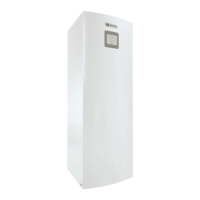
